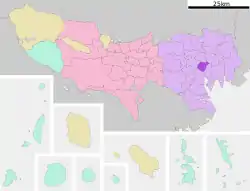Nippon Budokan
Nippon Budokan (日本武道館, Nippon Budōkan), often shortened to simply Budokan, is an indoor arena located in Chiyoda, Tokyo, Japan. Budokan was originally built for the judo competition in the 1964 Summer Olympics, hence its name, which translates in English as Martial Arts Hall. Its primary purpose is to host martial arts contests and for a time was a popular venue for Japanese professional wrestling. It has hosted numerous other sporting events such as the 1967 Women's Volleyball World Championship and other events such as musical concerts.
日本武道館 | |
Budokan | |
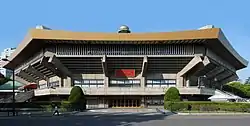 | |
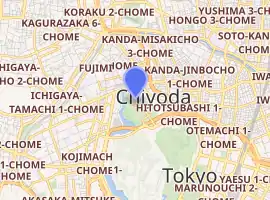
| |
| Location | 2-3 Kitanomarukōen, Chiyoda, Tokyo 102-8321, Japan |
|---|---|
| Coordinates | 35°41′36″N 139°45′00″E |
| Public transit | Tokyo Metro/Toei Subway (at Kudanshita): S Toei Shinjuku Line T Tozai Line Z Hanzomon Line |
| Owner | The Nippon Budokan Foundation |
| Capacity | 14,471 |
| Field size | Height: 42 m (140 ft) |
| Construction | |
| Built | 1964 |
| Opened | October 3, 1964 |
| Renovated | 2020 |
| Construction cost | 2 billion Japanese yen (5.6 million USD in 1964) |
| Architect | Mamoru Yamada |
| Main contractors | Takenaka Corporation |
A number of famous rock music acts have played at Budokan. The Beatles were the first rock group to play there, in a series of concerts held between June 30 and July 2, 1966. Another big act to enter the stage at Budokan were ABBA. They ended their last tour there, ABBA: The Tour. Their final show, on March 27, 1980, also came to be the last live concert they did together. Several live albums were recorded at Budokan, including releases by Bryan Adams, Bob Dylan, Eric Clapton, Cheap Trick, Dream Theater, Kiss, Mr. Big, Ozzy Osbourne, Judas Priest, Journey and Deep Purple.
Location
The Nippon Budokan is located in Kitanomaru Park in the center of Tokyo, two minutes' walking distance from Kudanshita Subway Station, and near the Imperial Palace and Yasukuni Shrine. The 42 m (140 ft) high octagonal structure holds 14,471 people (arena seats: 2,946, 1st floor seats: 3,199, 2nd floor seats: 7,846, standee: 480).[1] The building is modeled after Yumedono (Hall of Dreams) in Hōryū-ji in Nara.
Venue history
Martial arts
_2.jpg.webp)

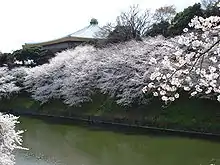
Although it also functions as a venue for big musical events, its primary purpose is for Japanese martial arts. The national championships of the different branches of the martial arts (judo, kendo, karate, aikido, etc.) are held annually at the Budokan. The Budokan has also been associated with professional wrestling's big shows, typically from All Japan Pro Wrestling and Pro Wrestling Noah. However, due to declining business following the death of Mitsuharu Misawa and the retirement of Kenta Kobashi, professional wrestling has ceased running regular shows in the Budokan. During Wrestle Kingdom 12, New Japan Pro Wrestling announced that its yearly G1 Climax tournament's finals would be held at the Budokan.[2]
The Muhammad Ali vs. Antonio Inoki hybrid rules fight held at the Budokan in 1976 is seen as a forerunner to mixed martial arts. K-1, Shooto and Pride Fighting Championships have all held events at the arena.
Music
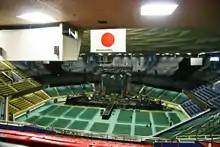
The Beatles were the first rock group to perform at Budokan in a series of five shows held between June 30 and July 2, 1966.[3] Their appearances were met with opposition from those who felt the appearance of a western pop group would defile the martial arts arena.[4]
In July 1973 Japanese television recorded the Santana performance at Budokan.
The Budokan gained worldwide fame when American artists Cheap Trick and Bob Dylan used the arena to record their performances, Cheap Trick at Budokan (1978) and Bob Dylan at Budokan (1979). The venue is popular for recording live albums because it has good acoustics, is relatively large and Japanese audiences are known for being highly appreciative when appropriate but quiet during performances.[5] Eric Clapton described the Tokyo audience as "almost overappreciative" in interviews promoting Just One Night (1980), his own live album recorded at the Budokan.
The record for the most Budokan music concerts is held by Eikichi Yazawa, 142 times as of December 19, 2017.[6]
Artists that have released live recordings from the venue include:
1970s
- Led Zeppelin; September 23 and 24, 1971 and October 2 and 3, 1972.
- Chicago; June 8, 1972.
- Uriah Heep; 1973, (Live concert filmed on 16mm for television. DVD versions available[7])
- Deep Purple; 1972; for the last of the three concerts making up their Made in Japan live album.
- The Moody Blues; January 18, 1974
- The Carpenters; June 7–9, 1974; Live in Japan
- Focus; June 20, 1975
- Queen; 1975, 1976, and 1979.
- Rainbow; December 16, 1976; On Stage Rainbow performed here both afternoon and evening shows at 3:00 pm and 6:00 p.m.
- Aerosmith; 1977 (Jan-Feb); see the Japanese record Rocks Budokan (label Calm&Storm).
- Fleetwood Mac; December 5, 1977 and February 3, 4th and 5, 1980
- Bay City Rollers; 1977; released as Rollerworld: Live at the Budokan 1977 in 2001.
- Pink Lady; 1977 (Bye Bye Carnival) and 1979 (Live in Budoukan).
- Kiss; 1977 and 1978.
- Cheap Trick; April 27, 28 and 30, 1978; Cheap Trick at Budokan (and the later-released 1998 album at Budokan: The Complete Concert).
- Ian Gillan Band; 1977–1978; Live at the Budokan (Vols. 1-2).
- Eric Clapton; December 1979; Just One Night.
- Diana Ross; 1977; "An Evening with Diana Ross" concert was videotaped during her 1977 tour.
- Coloratura Soprano Julie Andrews; 1977 "An Evening with Julie Andrews" concert was part of a highly acclaimed sold out national tour of Japan by Julie Andrews
- Eikichi Yazawa; 1977; Super Live Nippon Budokan, recorded his Budokan concerts of 1977.
- Gregg Allman Band and Cher ; June 29, 1977
- Bob Dylan; 1979; Bob Dylan at Budokan, recorded during his 1978 world tour.
- Earth, Wind & Fire; 1979.
1980s
- Sadao Watanabe; 1980; How's Everything.
- ABBA; 1980;
- Momoe Yamaguchi; 1980; Budokan at Last
- Yellow Magic Orchestra; 1980; Live at Budokan 1980, recorded 1980, released 1993.
- The Police; 1981; Budokan Radio On, released 1988.
- Michael Schenker Group; 1981; One Night at Budokan, released in 1982, deluxe edition released in 2009
- Quincy Jones; 1981; Quincy Jones Live at the Budokan.
- Journey; 1982; "Escape Tour". 1983; "Frontiers Tour".
- Styx; 1982;
- Toto; 1982; Live at Budokan 1982, Toto IV Tour.
- Japan; 1982; Live from the Budokan 1982, Final Tour (Some songs included Yellow Magic Orchestra members Yukihiro Takahashi and Ryuichi Sakamoto).
- Spinal Tap; 1982; "Smell The Glove Tour".
- Dave Grusin; 1983; Dave Grusin and the NY-LA Dream Band
- Grover Washington, Jr.,Pieces of A Dream; 1983; Aurex Jazz Festival
- Michael Schenker Group; 1982; One Night at Budokan.
- Asia; 1983; Live at Budokan, Asia in Asia.
- Gary Moore; 1984; We Want Moore! during the Victims of the Future tour in 1984, remastered 2002 (Budokan was one of the 4 or 5 different venues where this album was recorded)
- Frank Sinatra; 1985; Live at the Budokan Hall, Tokyo
- Phil Collins; 1985; The No Jacket Required World Tour
- Queen; 1981 and 1985.
- Judas Priest; 1986; "Fuel for Life Tour"
- Iron Maiden; 1987, "Somewhere on tour"
- Dead or Alive; 1987 video Rip It Up Live (VHS/Laserdisc)
- Kiss; 1988; "Crazy Nights Tour"
- Stryper 1989; "In God We Trust tour
1990s
- X Japan; 1990; Rose & Blood Tour
- Seiko Matsuda - Precious Moment ~1990 Live at Budokan~
- X Japan; 1991.
- Loudness - Live Loudest at the Budokan '91
- B'z - Just Another Life (1991).
- X Japan; 1992; Extasy Summit 1992.
- Tin Machine; 1992; who recorded a portion of Tin Machine Live: Oy Vey, Baby, during the It's My Life Tour.
- Skid Row - Live at Budokan, Tokyo 1992.
- Diana Ross, Tokyo 1992; 'The Force Behind the Power World Tour'
- X Japan; 1993.
- The Doobie Brothers; 1993; Live at Budokan.
- Aerosmith; 1994; Get a Grip Tour.
- Yngwie Malmsteen; 1994; video Live at Budokan 94, VHS/DVD.
- Blur; 1995-6; recorded a live compilation CD, Live at the Budokan, in 1995, at the height of Britpop; it was released in 1996.
- Chic; 1996; performance later released as Live at the Budōkan (1999). This was bassist Bernard Edwards's last performance; he died the next day.
- Diana Ross; 1996; 'Take Me Higher World Tour'
- Prince; 1996 Prince performed four concerts during the year as the Artist formerly known as Prince.
- Mr. Big; 1997; recorded Live at Budokan in 1997.
- Oasis; 1998; Oasis performed three nights in a row during their 'Be Here Now tour'.
- Puffy; 1998; Recorded Jet Tour '98 in support of the album Jet-CD.
- Malice Mizer; 1998; two night stint at the Budokan in support of Merveilles, which yielded their live video Merveilles ~Shuuen to Kisuu~ L'Espace.
- Journey; 1998; Recorded several songs from their Frontiers Tour in 1983 at the Budokan which was included on their live album Greatest Hits Live.
- Lauryn Hill; 1999; The Miseducation Tour (two sold-out shows)
- Janet Jackson; 1999; The Velvet Rope Tour (five sold-out shows)[8]
- Faye Wong; 1999; Budokan Live (for further information see: Faye Wong#1999: Venturing into Japan).
2000s
- Bryan Adams; 2000; Live at the Budokan.
- Morning Musume; 2000; DVD Morning Musume First Live at Budōkan: Dancing Love Site 2000 Haru (Also Sayaka Ichii's graduation from the group)
- Malice Mizer; 2-night stint at the Budokan in support of Bara no Seidou, which yielded their live video Bara ni Irodorareta Akui to Higeki no Makuake.
- Bay City Rollers; 2001; Rollerworld, Live at the Budokan 1977, released as Rollerworld: Live at the Budokan 1977 in 2001.
- Ozzy Osbourne; 2002; filmed CD/DVD combination Live at Budokan.
- Pearl Jam; 2003; recorded an official bootleg at Budokan during their Riot Act Tour (for further information see: Pearl Jam#Riot Act: 2002–2005).
- Duran Duran; July 11 + 12, 2003; played at Budokan;[9] shows recorded live[10]
- Mariah Carey; 2003; performed three concert shows, part of her Charmbracelet World Tour on July 6, 8 and 10.
- Incubus; March 3, 2004; performed at Budokan and show recorded as CD Live in Japan 2004 on June 1, 2004
- Dream Theater; 2004; 2DVD/3CD Live at Budokan.
- Hikaru Utada; July 28, 2004; video Utada Hikaru in Budokan 2004: Hikaru no 5.
- Judas Priest; 2005; DVD Rising in the East.
- Nana Mizuki; 2005; DVD Nana Mizuki Live Rainbow at Budokan.
- Avril Lavigne; 2005; DVD Live at Budokan: Bonez Tour, Bonez Tour.
- Hikaru Utada; 2006; video Utada United 2006 (Hikaru Utada discography#Video Releases)
- Nana Mizuki; 2006; DVD Nana Mizuki Livedom -Birth- at Budokan.
- MUCC; 2006; DVD World Tour Final Nippon Budokan 666
- Morning Musume; 2006; DVD Morning Musume Concert Tour 2006 Aki: Odore! Morning Curry
- The Gazette; 2006; DVD Standing Live Tour 2006 [Nameless Liberty. Six Guns...] Tour Final at Nippon Budokan.
- TM Network; 2007; video TM Network -Remaster- at Nippon Budokan 2007.
- TVXQ; 2007; Tohoshinki 2nd Live Tour 2007: Five in the Black.
- Perfume; 2008; "Budokaaaaaaaaaan!!!!!".
- Joe Hisaishi; 2008; Joe Hisaishi in Budokan – 25 years with the Animations of Hayao Miyazaki.
- Flow; 2008; Flow Live Tour 2007–2008 'Isle' Final at Nippon Budokan
- Chatmonchy; 2008; [Restaurant Main Dish] Live at : Budokan 2008.
- Nana Mizuki; 2009; Blu-ray/DVD Nana Mizuki Live Diamond x Fever.
- MUCC; 2009; DVD -MUCC Live Chronicle 3 "Kyutai" in Nippon Budokan-
- Mr. Big; 2009; live CD/DVD Back to Budokan.
- AKB48; 2009; AKB104 Senbatsu Members Sokaku Matsuri
- The Pillows; 2009; live DVD Lostman Go to Budokan.
2010s
- Dir En Grey; January 9–10, 2010; live DVD Uroboros: With the Proof in the Name of Living... At Nippon Budokan.
- An Cafe; January 14, 2010; King of Harajuku Dance Rock.
- Backstreet Boys; February 18, 2010; recorded live DVD Backstreet Boys: This Is Us Japan Tour 2010 on the This Is Us Tour.
- Nico Touches the Walls; March 12, 2010; "Walls is Auroras" LIVE.
- Polysics; March 14, 2010; Budokan or Die!!!! 2010.3.14
- One Ok Rock; 2010; live DVD This Is My Budokan?!.[11]
- Morning Musume; 2011; Ai Takahashi's graduation concert "Ai Believe ~Takahashi Ai Graduation Memory Special~.
- F.T. Island; 2011; Live in Budokan 'Summer Mesengger Tour'.
- MUCC; 2011; live DVD Chemical Parade
- Vivid (band) January 7, 2012; Take Off: Birth to the New World
- Judas Priest; February 16 & 17, 2012; Epitaph World Tour
- 2PM; 2012; 2PM Six Beautiful Day Live in Budokan
- Milky Holmes; 2012; Milky Holmes Live in Budokan
- Lee Seung-gi; 2012; First Japan Live in Budokan Kidou (Hope).[12]
- T-ara; 2012; Live in Budokan, recording of a concert performed as part of their Jewelry Box tour
- Dream Morning Musume; March 10, 2012; Dream Morning Musume Special Live 2012 Nippon Budokan~Dai 1 Shou Shuumaku 'Yuusha tachi, Shuugou seyo'
- U-KISS; 2012; live DVD U-KISS Live in Budokan.
- Morning Musume; 2012; Risa Niigaki and Aika Mitsui's graduation concert Ultra Smart.
- Scandal; March 28, 2012; Japan Title Match Live 2012: Scandal vs Budokan
- Sonar Pocket; August 3, 2012; Sonapokeizm Special - Natsu no Jin - in Nippon Budokan
- Acid Black Cherry; 2012; "Live DVD Acid Black Cherry Tour 『2012』".
- Spyair; December 18, 2012;
- Morning Musume; 2013; Reina Tanaka's graduation concert, Michishige☆Eleven Soul.
- °C-ute; 2013; Queen of J-Pop ~Tadoritsuita Onna Senshi~.
- AKB48; 2013; AKB48 Group Rinji Soukai "Shirokuro tsukeyou janai ka!"
- T-ara; 2013; T-ara Japan Tour 2013: Treasure Box.
- Morning Musume; 2013; ~Chance!~
- Berryz Kobo; 2013; Berryz Koubou 10 Shuunen Kinen Budokan Special Live ~Yappari Anata Nashi de wa Ikite Yukenai~
- AKB48 Group Research Students; 2013; AKB48 Group Kenkyuusei Concert ~Oshimen Hayai Mono Gachi~
- Super Junior KRY; 2013; Special Japan tour Super Junior K.R.Y. Special Winter Concert
- Mamoru Miyano; October 4, 2013; MAMORU MIYANO SPECIAL LIVE 2013 ~TRAVELING!~ first male voice actor to uphold a one man show in Budokan[13]
- LiSA; January 3, 2014; Live Is Smile Always - Kyo mo Ii Hi Da - In Nippon Budokan[14]
- Avril Lavigne; February 4 and 5, 2014: The Avril Lavigne Tour
- Babymetal; March 1 and 2, 2014 ; Live at Budokan: Red Night & Black Night Apocalypse
- Dir En Grey; March 8–9, 2014; Dum Spiro Spero at Nippon Budokan
- S/mileage; July 15, 2014; S/mileage Live 2014 Natsu Full Charge ~715 Nippon Budokan~
- Junho (from 2PM); August 12 and 13, 2014; "Feel" Solo Tour in Japan 2014
- Dish; January 1, 2015
- LiSA; January 10 and 12, 2015; LiVE is Smile Always - PiNK & BLACK - in Nippon Budokan[15]
- Silent Siren; January 17, 2015; Silent Siren Live Tour 2014–2015 Fuyu ~Budokan e Go! Siren Go!~ at Budokan
- Oldcodex; February 11, 2015; "Capture" in Budokan
- Mamoru Miyano; 2015; MAMORU MIYANO LIVE TOUR 2015 ~AMAZING!~ final at Budokan[16]
- Kalafina; February 28, 2015; Kalafina Live Best 2015 "Red Day". March 1, 2015; Kalafina Live Best 2015 "Blue Day"
- The Gazette; March 3, 2015; 13th Anniversary Nippon Budokan
- Judas Priest; March 11, 2015; Redeemer of Souls Tour
- Kana-Boon; March 31, 2015
- Morning Musume; May 27, 2015; ~Gradation~.
- 己龍 (Kiryu); July 31, 2015
- Hatsune Miku; September 4–5, 2015; Magical Mirai.
- Eir Aoi; November 2, 2015; Eir Aoi Special Live 2015 World of Blue at Nippon Budokan
- Angerme; November 29, 2015, Angerme First Concert Tour 2015 Aki "Hyakka Ryouran" ~Fukuda Kanon Sotsugyou Special~
- Morning Musume; December 7–8, 2015; ~Prism~.
- Dish; January 1–2, 2016; 4 Monkey Magic.
- Wagakki Band; January 6, 2016; Dai Shinnenkai 2016 Nippon Budokan -Akatsuki no Utage-.
- Scandal; January 12–13, 2016; SCANDAL ARENA TOUR 2015–2016 「PERFECT WORLD」
- Mamoru Miyano; 2016; MAMORU MIYANO LIVE TOUR 2015-16 ~GENERATING!~ final at Budokan[17]
- Dir En Grey; February 5–6, 2016; Arche at Nippon Budokan
- iKon; February 15–16, 2016; iKoncert 2016: Showtime Tour
- Symphogear; February 27–28, 2016; Symphogear Live 2016
- YuiKaori; March 12, 2016; RAINBOW CANARY!! ~Brightest Stage~
- Shouta Aoi; March 13, 2016; Wonder Lab. ~Bokutachi no Sign~
- Aya Uchida; August 13, 2016; AYA UCHIDA Complete LIVE 〜COLORS〜 in Nippon Budokan
- Kalafina; September 16–17, 2016; Kalafina Arena LIVE 2016
- Queen + Adam Lambert; September 21–23; Queen + Adam Lambert 2016 Summer Festival Tour
- Suzuko Mimori; October 27–28, 2016; Mimori Suzuko Live Tour 2016 "Grand Revue" Final at Nippon Budokan
- Eir Aoi; November 4–5, 2016; Eir Aoi 5th Anniversary Special Live 2016 ~Last Blue~ at Nippon Budokan
- My First Story; November 18, 2016; We're Just Waiting 4 You Tour 2016 Final at Budokan
- Journey; February 7, 2017; recorded live CD/DVD Live in Japan 2017
- ClariS; February 10, 2017; ClariS 1st Budōkan Concert ~Futatsu no Kamen to Ushinawareta Taiyō~ (ClariS 1st Budōkan Concert: Two Masks and the Lost Sun)
- Versailles; February 14, 2017; Chateau de Versailles at Nippon Budokan
- The Oral Cigarettes; June 16, 2017; Unofficial Dining Tour 2017 at Nippon Budokan
- Taemin; July 1–2, 2017; TAEMIN The 1st Stage Nippon Budokan
- Blackpink; July 20, 2017, Japanese Debut Showcase
- After the Rain; August 9–10, 2017; AtR -Clockwise / Anti-Clockwise-
- Poppin'Party (BanG Dream!); August 21, 2017; BanG Dream! 4th☆LIVE Miracle PARTY 2017![18]
- Aimer; August 29, 2017; Live in Budokan "blanc et noir"
- Dream Theater; September 11, 2017; Back to Budokan 2017
- Nana Mizuki; January 11–21, 2018; NANA MIZUKI LIVE GATE 2018
- Kalafina; January 23, 2018; Kalafina 10th Anniversary LIVE 2018 at Nippon Budokan
- coldrain; February 6, 2018; FATELESS JAPAN TOUR 2017
- Winner; April 28, 2018; WINNER Japan Tour 2018 ~We'll always be young~
- Mariah Carey; October 31 and November 1, 2018; #1's Tour (two sold-out shows)
- Maaya Uchida; January 1, 2019; UCHIDA MAAYA New Year LIVE 2019「take you take me BUDOKAN!!」[19] (sold-out concert)[20]
- Ensemble Stars!; January 13, 2019; Ensemble Stars! Starry Stage 2nd ~in Nippon Budokan~[21]
- Milky Holmes; January 28, 2019; Milky Holmes Final Live Q.E.D.
- Janet Jackson; February 10 and February 11, 2019; State of the World Tour (two sold-out shows)[22]
- Roselia, Raise A Suilen, and Poppin'Party (BanG Dream!); February 21–23, 2019; BanG Dream! 7th☆LIVE[23][24][25]
- Inori Minase; June 28–29, 2019; Inori Minase LIVE TOUR 2019 Catch the Rainbow![26]
American crossover thrash band Stormtroopers of Death released a live album titled Live at Budokan (1992), though the title was in jest and the album was recorded at famed New York City venue The Ritz.
The original Beatles concert is heavily bootlegged on audio and video;[27] the first night's concert video was officially released by Apple Records in Japan only as Beatles Concert at Budokan 1966, and excerpts are shown in The Beatles Anthology, while the second Anthology album included the first show's performances of "Rock and Roll Music" and "She's A Woman". The venue is one of the stages in The Beatles: Rock Band video game.[28] Chatmonchy currently holds the record for the largest crowd at Budokan.
South Korean girl group T-ara was the first Korean female artist to perform in Nippon Budokan in 2012 and the only Korean female artist to perform there twice in 2013. In 2017, Blackpink became the second such group to perform at the venue.
Other events
The National Memorial Service for War Dead is held with the attendance of the Prime Minister, the Emperor and the Empress annually in Budokan on August 15, the day of Japan's surrender.
As well as holding the Live Concert in appreciation of the Popular Anime series Lucky Star: Live in Budokan (Anata No Tame Dakara).
A concert was held in honor of Studio Ghibli's 25th anniversary at the Budokan, hosted by Joe Hisaishi. It included repertoire from most of the films Hisaishi composed for Hayao Miyazaki's Studio Ghibli filmography.
Diana Ross performed and taped her "Here and Now" television special in 1991 to a sold-out audience.
The Japan Record Awards took place in the arena from 1985 to 1993 where all of the artists from around the country receive these awards.
Muhammad Ali won a unanimous decision over Mac Foster in their 1972 heavyweight boxing match.
On February 13, 1975, a religious gathering was held to hear Rev. Sun Myung Moon speak.[29]
On August 27, 2011, Japan's three biggest professional wrestling promotions; All Japan Pro Wrestling, New Japan Pro Wrestling and Pro Wrestling Noah came together to produce a charity event titled All Together at the arena. On August 10, 11 and 12, 2018 New Japan Pro Wrestling held the final 3 days of the G1 Climax in the Budokan, which marked the first time in 15 years that New Japan has promoted an event there. New Japan once again returned to the arena for the final 3 days of the 2019 G1 Climax.
Professional wrestler and legend in Japan Kenta Kobashi wrestled his final match in Budokan on May 11, 2013, at an event titled Final Burning in Budokan. Kobashi is synonymous with the arena along with fellow wrestlers Toshiaki Kawada and the late Mitsuharu Misawa.
In November, the Budokan is a two day-venue for the annual Japan Self-Defense Forces Marching Festival, a yearly tradition and the nation's military tattoo first held here in the fall of 1963. Aside from JSDF bands, foreign armed forces military bands are also invited to join the event.[30]
Other uses
The Nippon Budokan is the primary setting of the 1989 fighting game Budokan: The Martial Spirit. Players train in various Japanese martial arts, and must then face off at the Budokan arena against computer-controlled opponents.
A fictional concert hall based on Nippon Budokan appeared in the music video game Guitar Hero III: Legends of Rock (2007) under the name "Kaiju Megadome". The Beatles' appearance at Nippon Budokan was featured in The Beatles: Rock Band (2009).
Another fictional hall based on the Nippon Budokan appeared in the Japanese pro-wrestling video game Virtual Pro Wrestling 2: Ōdō Keishō (2000).
References
- 日本武道館建物概要(アリーナ面積・座席表) (in Japanese). Nippon Budoukan. Retrieved July 4, 2014.
- "A stacked lineup of shows announced for NJPW in 2018, including a return to the legendary Budokan Hall! | NEW JAPAN PRO-WRESTLING". NJPW.
- Swanson, Dave. "50 Years Ago: The Beatles Headline in Japan". Ultimate Classic Rock. Retrieved November 26, 2017.
- "Japan keeps Lennon's memory alive". BBC News. December 8, 2008. Retrieved April 7, 2010.
- https://www.ajournalofmusicalthings.com/history-question-why-were-so-many-live-albums-recorded-at-japans-budokan-theatre/
- 矢沢永吉、今年もヨロシク武道館 止まらない最多更新142回へ (in Japanese). Sponichi Annex. Retrieved July 7, 2017.
- Personal memoir, Todd Fischer
- "Janet Jackson The Velvet Rope Tour (1998-1999)". Jackson Source. January 1, 2010. Retrieved February 10, 2019.
- "Duran Duran Music". Duran Duran Music. Retrieved November 13, 2015.
- "Duran Duran DURAN DURAN TIMELINE". Duran Duran. Retrieved November 13, 2015.
- "see 'other'". Archived from the original on May 29, 2010.
- "Lee Seung-gi Mesmerizes Fans in Japan's Budokan". HanCinema. Retrieved November 13, 2015.
- "MAMORU MIYANO SPECIAL LIVE 2013 ~TRAVELING!~ / 宮野真守". 宮野真守 OFFICIAL WEB SITE.
- "LiSA、自身初の日本武道館ライブを振り返る - 「LiVE is Smile Always~今日もいい日だっ~in日本武道館」 (1) 日本武道館までの道程". マイナビニュース. June 17, 2014.
- "[LiSA]LiVE is Smile Always~PiNK & BLACK~ in 日本武道館「いちごドーナツ」&「ちょこドーナツ」ライブ映像を4週連続で配信スタート☆". www.sma.co.jp.
- "MAMORU MIYANO LIVE TOUR 2015 ~AMAZING!~ / 宮野真守". 宮野真守 OFFICIAL WEB SITE.
- "MAMORU MIYANO LIVE TOUR 2015-16 ~GENERATING!~ / 宮野真守". 宮野真守 OFFICIAL WEB SITE.
- Komatsu, Mikikazu (June 28, 2017). "Tickets for "BanG Dream!" Budokan Concert in August Already Sold Out". Crunchyroll. Retrieved May 26, 2020.
- 制作者. "2019年1月1日、日本武道館でのライブが決定! | 内田真礼オフィシャルサイト". 2019年1月1日、日本武道館でのライブが決定! | 内田真礼オフィシャルサイト (in Japanese). Retrieved November 2, 2018.
- "内田真礼 Official STAFF on Twitter". Twitter. Retrieved November 24, 2018.
- "キャストライブ『あんさんぶるスターズ!Starry Stage 2nd 〜in 日本武道館〜』|スタステ2nd特設サイト". キャストライブ『あんさんぶるスターズ!Starry Stage 2nd 〜in 日本武道館〜』|スタステ2nd特設サイト (in Japanese). Retrieved February 25, 2019.
- "Janet Jackson State of the World Tour 2019". Creativeman Productions. December 21, 2018. Retrieved February 10, 2019.
- "武道館初単独ライブ!「BanG Dream! 7th☆LIVE」DAY1:Roselia 「Hitze」ライブレポート" [Budokan first solo live! "BanG Dream! 7th ☆ LIVE" DAY1: Roselia "Hitze" Live Report]. Inside Games (in Japanese). March 26, 2019. Retrieved May 28, 2020.
- "日本武道館をRASの色で染め上げた「BanG Dream! 7th☆LIVE」DAY2をレポート" [Report on DAY2 of "BanG Dream! 7th ☆ LIVE", which dyed Nippon Budokan with RAS color]. Gamer (in Japanese). February 24, 2019. Retrieved May 28, 2020.
- "『バンドリ!』日本武道館の『BanG Dream! 7th☆LIVE』のDAY3では"Poppin'Party"が登場" ["BanG Dream! "Poppin'Party" appeared in DAY3 of "BanG Dream! 7th ☆ LIVE" at Nippon Budokan]. Famitsu (in Japanese). February 25, 2019. Retrieved May 26, 2020.
- "Inori Minase LIVE TOUR 2019 Catch the Rainbow!特設ページ". www.inoriminase.com. Retrieved May 29, 2019.
- Unterberger, Richie (2006). The Unreleased Beatles: Music & Film. Hal Leonard Corporation. pp. 321–322. ISBN 978-0-87930-892-6.
- The Beatles Rock Band: If I Needed Someone- Sight Read (100% FC Gold Stars). YouTube. September 5, 2009. Retrieved November 13, 2015.
- http://www.tparents.org/UTS/DoH2/DOH2-13.pdf
- "DVIDS - News - III MEF Band impresses at Budokan". DVIDS. Retrieved November 13, 2015.
External links
| Wikimedia Commons has media related to Nippon Budokan. |
- Nippon Budokan official website (in Japanese)
- Nippon Budokan Map
- 1964 Summer Olympics official report. Volume 1. Part 1. pp. 128–30.
| Preceded by Imperial Garden Theater |
Host of the Japan Record Awards 1985–1993 |
Succeeded by TBS Broadcast Center |

